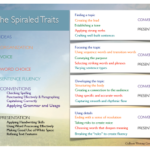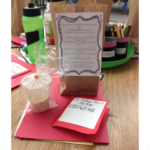I have been reading the raved about
The Book Whisperer by Donalyn Miller
It really is wonderful. I love to read and have always had my nose stuck in a book.
Since teaching, it is usually something I am reading to better myself as an educator rather than just for pleasure. I am excited that The Book Whisperer has reminded me just how much I love to read for fun. I usually read 3 or 4 books over holiday breaks and several more over the summer. This book was an amazing reminder of how important it is to allow our little readers to develop a natural love of literacy, something that they are not able to obtain through force. We need to give our kids time to fall into their books.
I love the Daily 5. I have used it every year since my student teaching. Every year I change the overall structure of my time, though. I often feel like the little 15 minute chunks are not enough for my readers to settle into and get lost in their books. By adding work on writing, word work, listen, buddy and read to self my kids really aren’t getting the time they desperately need with self selected texts.
As I return to work on Monday I plan to make some changes this year, as well.
ONE:
Listen to Reading for “dormant” readers every day!
I know the students who are “dormant” readers. Reading is challenging and they dread it in every way.
These are the readers who need to be allowed to listen to reading more frequently than those who are active readers. All readers light up at listening to a read aloud.
They are involved and engaged. They are visualizing, predicting, and hungry for more. I am going to utilize technology for students who need to be inspired by read alouds most and these are the “dormant” readers. This allows students who are “active” readers more of the time they need with independent reading.
TWO:
I will not use worksheets and multiple choice tests to confirm that my students have read and understand a text.
This takes away from the joy of reading. Miller commented that if adults had to take a multiple choice test on every television show they watched we would watch a lot less t.v. This is true of books too.
THREE:
No more work on writing.
We have a huge writing block. I will not have a work on writing session like I have in the past. The time we have in class to read is so important. There is less and less time to read at home. We live in an era where both parents are usually working. Parents are exhausted after a long day at work and the kids are just as tired. I can’t blame them. It takes everything for me to read to Conner before bed each night. Our eyelids are heavy and we want nothing more to snuggle together and fall asleep. This means the time we have in class for reading must be used for that and that alone. I am not using our writing time to read to why should we use our reading time to write. My kids are reading under tables as I am teaching. They can’t wait to get back to their books, so why not give them the time to do so rather than filling that time up with grammar worksheets and other writing assignments.
FOUR:
Eliminating the reading log.
I have not made the final decision yet, but I am thinking very seriously about eliminating reading logs. Miller discusses this in her book, too. Reading logs are supposed to tell us that kids are reading at home. Guess what, they don’t tell us squat! I remember having my mom sign my reading logs at the last possible second each week. She knew I had read but she didn’t time me. She didn’t force me to read. We read together and I read alone. At no point when we were reading did I stop to say “oh, let me get my reading log so you can sign it.” It takes away from the joy of reading. Those students who aren’t reading at home aren’t going to do so just because of a reading log either.
Reading logs are part of the culture of our school, though. I have a weekly behavior sheet in my students take home folders. I am thinking that somewhere on this form I will put a place for parents to add a single signature for the reading they are doing at home. This is something that will serve as a reminder to them that this is still a requirement. I will let you know more about how this goes.
Daily 5 is wonderful. The point of it is to engage the students in meaningful work so that the teacher may teach reading lessons that meet the needs of individuals and small groups of students. It is not a program and it does not work the same for everyone. I have not yet had a group of kids where I didn’t need to make changes in my Daily 5 system to meet the new needs a new class presented.
Don’t be afraid to play with Daily 5 and do what works best for you!
Onto your Freebie:
Last year our classes were so high {38} and this year they were projected to be just as high.
Thank goodness were only at the low number of 30 this year.
Last year I had so many options available for word work:
Stamp letters, play do words, painting words on chalkboard with water, scrabble words, dotty (bingo) words, magnetic letters, play-do stampers, lego letters, cube letters
I have always heard, read and felt like students are more likely to remain on task and be engaged if they are allowed choice. It’s not that I don’t believe this, but I don’t think it is always true. Kids last year we constantly off task when it came to work work. I didn’t feel like it was effective at the third grade level either. I wanted something that required them to think more and that I could hold them accountable to.
For this, I have created the weekly word work journal.
Each student has a book with word work for the whole year. Each week they complete all parts.
On Friday if they completed the weekly word work they get to choose free choice word work with the choices above. Simple as that!
Click any of the pictures below to grab your freebie! I hope you find it useful and remember to leave your feedback!!
















Leave a Reply